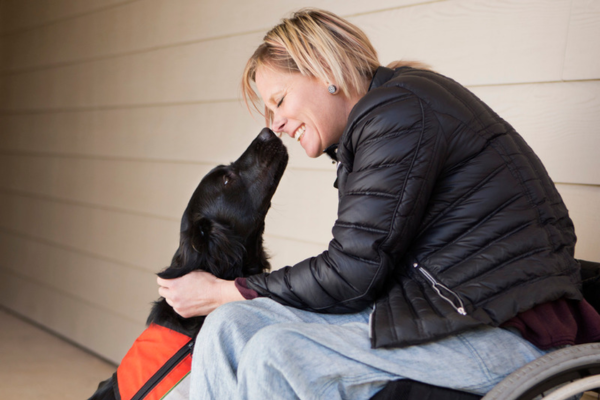Service dogs are irreplaceable companions for people with disabilities. They provide assistance drastically improving their quality of life and, in many cases, life-saving care. Unfortunately, many people have misconceptions about service dogs, leading to misunderstandings about them and their handlers. At Justice Speaks, we aim to debunk common myths and present facts to create a more informed and respectful environment for service dogs and their handlers.
Myth 1: Real Service Dogs Are Only For Blind People
Fact: Service dogs are traditionally known for assisting blind individuals. However, their roles extend far beyond helping the visually impaired. Service dogs can be trained to assist with a variety of disabilities. This can include mobility issues, hearing impairments, epilepsy, diabetes, and mental health issues such as PTSD. Service dogs are trained to perform tasks like alerting to seizures, providing balance support, retrieving items, and offering emotional support.
Myth 2: Service Dogs Are Pets
Fact: Service dogs are not pets—they have been certified through extensive service dog training to perform specialized tasks for their handlers. This is why interfering with a service dog is highly discouraged. Interacting with a service dog by petting, feeding, or distracting it can disrupt its work and put its handlers at risk.
Myth 3: Any Dog Can Be A Service Dog
Fact: Not every dog will be suitable as a service dog. Service dogs must undergo vigorous training to perform tasks and possess qualities such as calmness, focus, discipline, and sociability. Handlers are permitted to train their own service dogs, but the process for service dog certification is extensive. It also requires a deep understanding of the dog’s abilities and needs.
Myth 4: Service Dogs Are Required To Wear A Vest Or Have ID
Fact: Under the Americans with Disabilities Act, service dogs are not required to wear a vest or carry documentation to prove their status. Many service dog handlers want their dogs to wear vests or other gear in public. This is to make identifying their role easier, but it is not a legal requirement. In addition, service dog handlers are not obligated to provide documentation or disclose their disability when accompanied by their service dog.
Myth 5: Service Dogs Must Always Be Large Breeds Of Dogs
Fact: Service dogs come in various sizes and breeds. The choice of breed typically depends on the handler’s needs and preferences. Smaller dog breeds can be preferable for alerting to a medical condition or providing emotional support. Another benefit of a small-breed service dog is that it can be easier to care for and travel with!
Myth 6: Service Dogs Are Only For People With Visible Disabilities
Fact: Just as all humans are different from each other, so are their disabilities. Fortunately, service dogs can assist with both visible and invisible disabilities. Some “invisible” conditions such as epilepsy, diabetes, and mental health disorders like anxiety and depression may not be immediately apparent but can significantly benefit from the assistance of a service dog. The public must understand that the need for a service dog will not always be immediately apparent. Be sure to be respectful and refrain from asking service dog handlers about their disability unless they choose to share that information.
Myth 7: It’s Okay To Pet A Service Dog If The Handler Isn’t Looking
Fact: Even if a service dog is resting, seems to be taking a break, or their handler isn’t looking, it is never appropriate to pet or distract them. Service dogs are trained to focus on tasks; distractions can interfere with their work and put their handler in danger. Service dog handlers always appreciate it when the public respects them and their service dog, and they refrain from interaction unless invited.
Myth 8: Service Dogs Can Be Denied Access To Public Places
Fact: Under the Americans with Disabilities Act, service dogs are permitted in all public places, including restaurants, hotels, and stores. Businesses cannot deny access to individuals with service dogs. In addition, handlers are not required to provide documentation or disclose their disability to anyone. Service dog handlers are responsible for ensuring their service dogs are under control and respectful at all times in all environments.
Myth 9: All Dogs Wearing Vests Are Service Dogs
Fact: While vests sometimes indicate that a dog is a service dog, some people misuse vests and other gear to bring their pets into establishments where they wouldn’t otherwise be allowed. Actual service dogs have undergone extensive training; simply putting a vest on a dog does not make a dog a service dog.
Myth 10: Service Dogs Are Always Perfectly Behaved
Fact: While service dogs undergo significant training, they are still animals. Even the most well-trained service dog can still have off days or moments of distraction. If you see a service dog acting out, it’s likely due to a distraction or a medical issue, not a lack of training.
Understanding facts and myths about service dogs is critical for fostering a respectful and inclusive environment for those with disabilities. At Justice Speaks, we are dedicated to dispelling these common myths and better educating the public. This will help ensure these incredible service dogs can continue supporting those who need them.


